With the right lighting, your backyard, garden, or patio can become even more beautiful at night than it is during the day.
Professional landscape lighting is about much more than visibility or security. It’s an art form that extends your enjoyment of outdoor spaces, while also adding beauty, safety, and value to your home.
This guide explores how thoughtfully designed lighting can create an amazing evening experience.
From creating ambiance for entertaining to highlighting architectural details, you’ll learn how different techniques and fixtures can make your outdoor space a nighttime masterpiece.
Why Landscape Lighting Matters
Most homeowners think of outdoor lighting in purely practical terms: Illuminating the driveway, adding a porch light, placing a single spotlight in the backyard, etc.
While these are functional uses, they only scratch the surface of what’s possible.
Well-designed landscape lighting enhances every aspect of your outdoor living environment. Some of the most important benefits include:
- Enhanced Ambiance and Mood. The right lighting sets the tone, whether you want a soft glow for quiet evenings or a warm, welcoming atmosphere for gatherings.
- Increased Safety and Security. Pathways, steps, and dark corners are clearly visible, helping to prevent trips and deter unwanted visitors.
- Extended Outdoor Hours. Instead of retreating indoors at sunset, you can enjoy your patio, garden, or pool long into the night.
- Highlighting Features. Architectural details, prized plants, sculptures, or water features can become stunning focal points after dark.
- Boosted Property Value. A well-lit landscape improves curb appeal and gives your home a polished, high-end appearance.
Lighting, when approached as design rather than utility, can turn an ordinary yard into a luxurious outdoor retreat.
Popular Landscape Lighting Techniques
Professional lighting design isn’t about flooding your yard with brightness. It’s about strategic placement, layering, and creating balance.
Here are some of the most common and effective techniques:
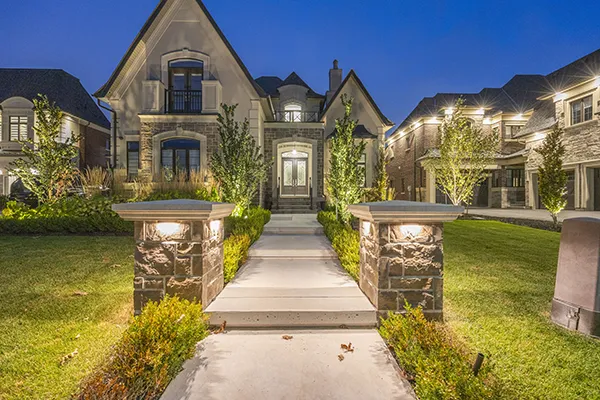
Path Lighting
Small fixtures line walkways, guiding guests safely while adding a welcoming glow. Path lights are subtle but important, ensuring movement feels both secure and inviting.
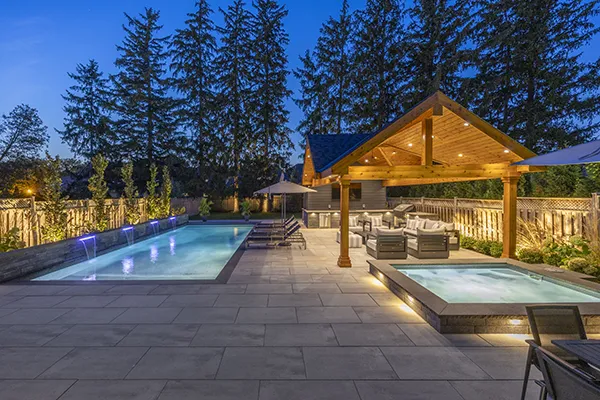
Uplighting
Positioning lights at the base of trees or structures and angling them upward creates dramatic effects. This technique highlights textures, adds depth, and makes tall trees or architectural details stand out.
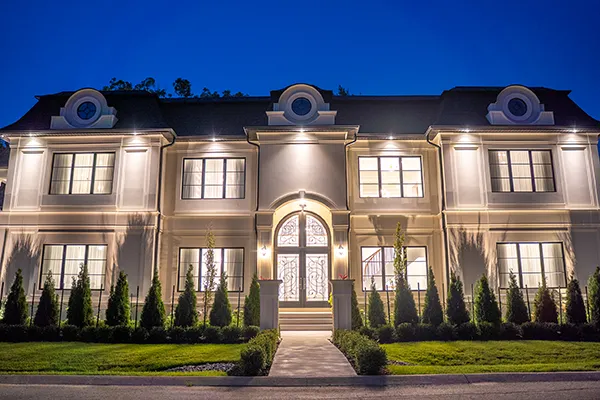
Downlighting (Moonlighting)
Fixtures placed high in trees or on structures mimic natural moonlight. The effect is soft and romantic, casting gentle shadows across lawns or patios.
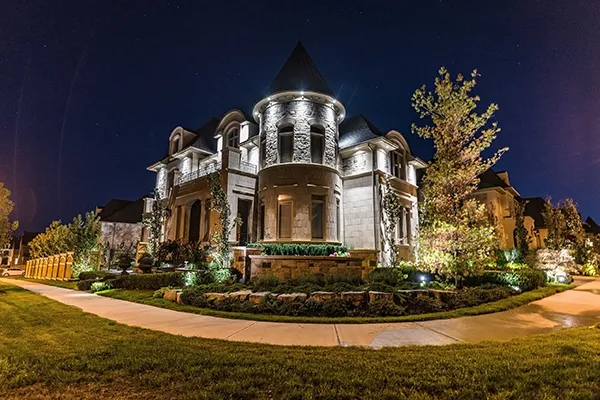
Spotlighting and Accent Lighting
Strong, focused beams draw attention to a particular feature, such as a statue, water fountain, or ornamental tree.
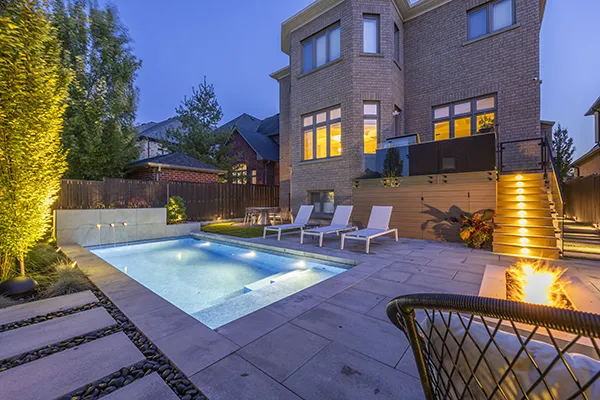
Step Lighting
Built directly into stair risers or adjacent walls, these lights increase safety while adding a sophisticated touch.
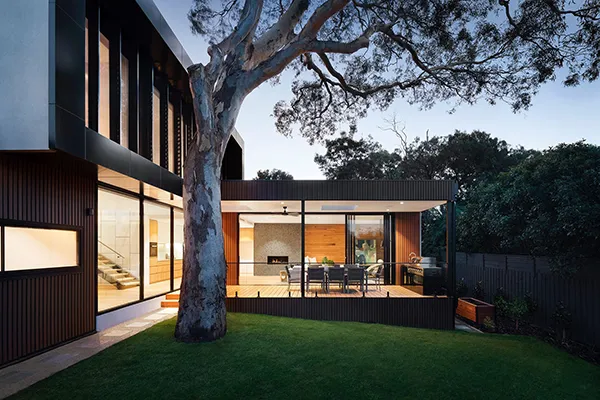
Deck & Patio Lighting
Fixtures can be integrated into deck and patio railings, under benches, or around seating areas, blending seamlessly into the design while still providing functional lighting.
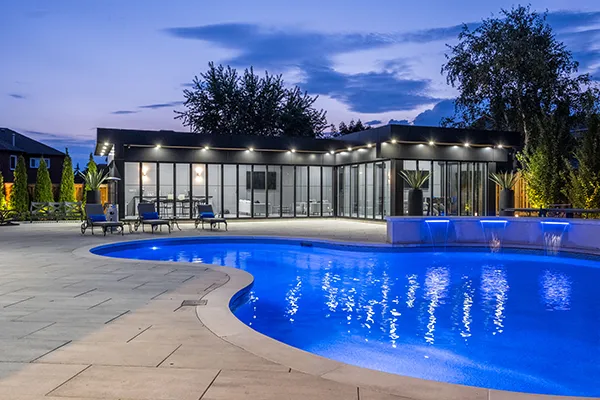
Pool & Water Feature Lighting
Water takes on an entirely new dimension with lighting. Reflections, ripples, and movement create mesmerizing visual effects that become natural focal points at night.
Choosing the Right Fixtures and Systems
Beyond placement and technique, the type of fixture and system you choose is equally important. Today’s homeowners have more options than ever before:
- LED Lighting. Energy efficient, long-lasting, and available in a wide range of styles and colour
- Solar Lights. Eco-friendly and easy to install, though typically less powerful and best for accent use.
- Low-Voltage Systems. A popular choice for residential landscapes, offering safety, efficiency, and flexibility in design.
- Fixture Styles. From modern and minimalist to classic and decorative, fixture design plays a role in how lighting complements your overall landscape.
When selecting fixtures, consider durability, energy use, and how well the design integrates into your outdoor aesthetic.
Tips for Creating a Balanced Lighting Design
An outdoor lighting plan should feel intentional and harmonious, not overwhelming. A few guiding principles include:
- Layer the Light. Combine different techniques to achieve depth and variety.
- Think in Zones. Divide your yard into areas, such as pathways, seating, or water features, and design lighting for each.
- Avoid Over-Illumination. Too much light can wash out the beauty of your space and create glare.
- Focus on Warm Tones. Warmer light temperatures (2700K–3000K) feel more inviting than harsh, bright white.
- Use Dimmers or Controls. Smart systems let you adjust lighting to suit different moods and occasions.
The goal is to make your outdoor space functional, safe, and visually stunning while still feeling natural.
The Luxury of Integrated Lighting
Luxury lighting design isn’t just about what you see during the day. It’s about creating an outdoor environment that feels magical around the clock.
One of the most common mistakes homeowners make is treating lighting as an afterthought, adding fixtures only once the rest of the landscaping is complete.
However, the most breathtaking results come when lighting is considered from the very beginning.
When integrated into the overall design, lighting complements and enhances every feature of the landscape. Outdoor structures and architectural elements are all brought into harmony through illumination.
Illuminate Your Evenings with Royal Stone Group
From subtle path lights to dramatic uplighting and serene water feature illumination, professional landscape lighting adds both elegance and function to your outdoor spaces.
Royal Stone Group brings expertise, creativity, and attention to detail to every project.
Our integrated lighting designs are crafted to highlight your home’s best features while ensuring safety, comfort, and year-round usability.
Let your landscape shine, day and night. Contact Royal Stone Group to discover how professional lighting can enhance your evenings.

